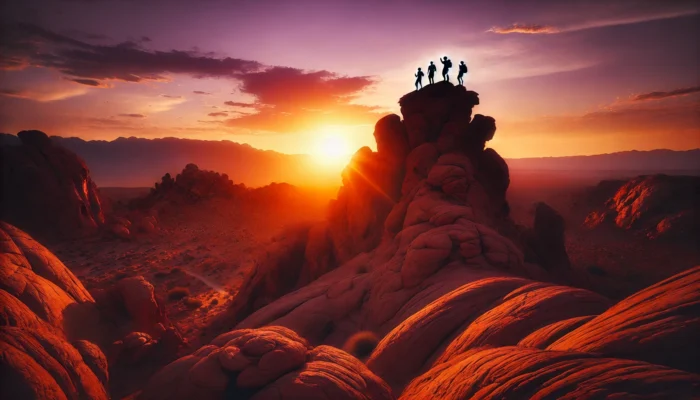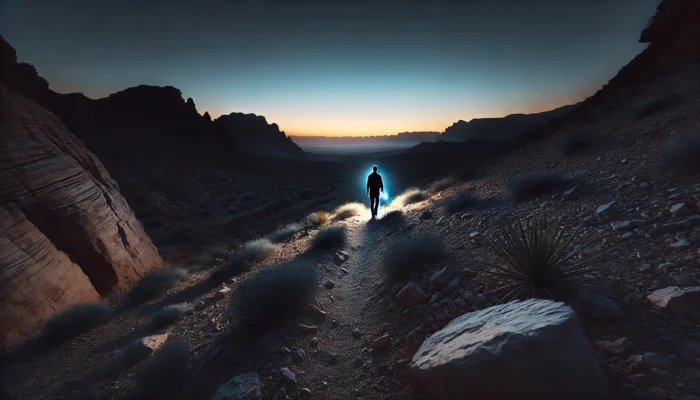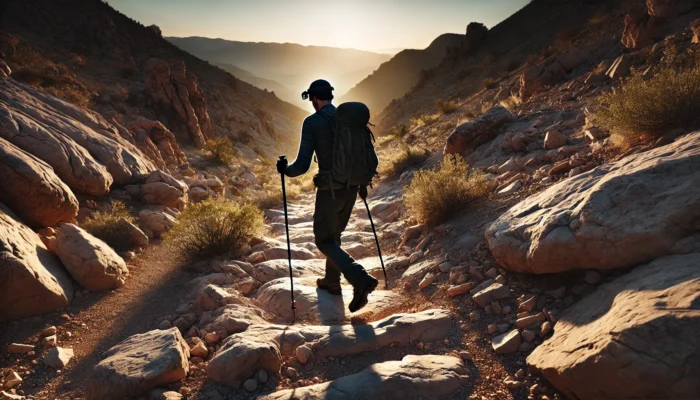Las Vegas is famous for its neon lights, world-class entertainment, and bustling nightlife, but the city also offers stunning natural landscapes that make for an unforgettable sunrise hiking experience. If you’re wondering how to plan a sunrise hike in Las Vegas, you’re in for a treat. Whether you’re a local looking to escape the Strip for a morning of tranquility or a visitor hoping to experience the breathtaking beauty of the Mojave Desert, this guide will help you plan the perfect early morning adventure.
Stop right here – Vegas insider tip: Most visitors to this site will overpay by $727+ per trip to Las Vegas. Why? Because they don't have the secrets and tips to keep expenses low in Vegas while having a good time. Want the complete playbook for traveling like a Vegas local? Click here to save money on Vegas trips
From Red Rock Canyon to the Valley of Fire, Las Vegas is surrounded by incredible hiking destinations that come alive with color at sunrise. Proper planning is essential to ensure a safe, enjoyable, and rewarding experience. Below, we’ll break down the best sunrise hiking spots, the ideal time to start, what to bring, and other important considerations for your trip.
Best Sunrise Hiking Spots Near Las Vegas
Las Vegas is surrounded by breathtaking hiking trails that come alive with color at sunrise. Whether you prefer red rock landscapes, alpine forests, or lakeside views, there’s a perfect trail for every adventurer. Here are the best spots to catch a stunning desert sunrise.

Red Rock Canyon National Conservation Area
Just 20 minutes from the Las Vegas Strip, Red Rock Canyon is a hiker’s paradise with towering red sandstone cliffs and scenic desert trails. At sunrise, the rocks glow with fiery hues, creating a breathtaking backdrop for an early morning adventure.
- Best sunrise hikes: Calico Tanks, Turtlehead Peak, and Keystone Thrust
- Distance from the Strip: About 20 minutes
- Difficulty levels: Easy to challenging
- Entrance fee: $20 per vehicle or $5 per pedestrian/biker
- Reservations required: Yes, for the scenic drive from October to May
Valley of Fire State Park
Known for its striking red sandstone formations and ancient petroglyphs, Valley of Fire is a must-visit for sunrise hikers. The park’s otherworldly landscapes are even more magical in the soft, golden morning light.
- Best sunrise hikes: Fire Wave, White Domes, and Mouse’s Tank
- Distance from the Strip: About 50 minutes
- Difficulty levels: Easy to moderate
- Entrance fee: $10 per vehicle for Nevada residents, $15 for non-residents
- Why go at sunrise: Avoids extreme heat and crowds
Mount Charleston
For a refreshing escape from the desert heat, Mount Charleston offers cool alpine trails and stunning sunrise views. With lush forests and rugged peaks, it’s the perfect spot for those seeking a higher-altitude adventure.
- Best sunrise hikes: Mary Jane Falls, Cathedral Rock, and Big Falls
- Distance from the Strip: About 45 minutes
- Difficulty levels: Moderate to strenuous
- Elevation: Over 7,000 feet, which makes for cooler temperatures
- Seasonal considerations: Snow may be present in winter and early spring
Lake Mead National Recreation Area
Combining desert beauty with shimmering blue waters, Lake Mead offers unique sunrise hiking opportunities. Trails here provide panoramic views of the lake, surrounding mountains, and diverse desert wildlife.
- Best sunrise hikes: Historic Railroad Trail, Owl Canyon, and Liberty Bell Arch
- Distance from the Strip: About 30 minutes
- Difficulty levels: Easy to moderate
- Entrance fee: $25 per vehicle, valid for 7 days
- Wildlife spotting: Bighorn sheep, coyotes, and desert tortoises
Sloan Canyon National Conservation Area
A hidden gem just outside Las Vegas, Sloan Canyon is home to fascinating petroglyphs and peaceful desert trails. With fewer crowds than other hiking spots, it’s an ideal destination for a quiet and scenic sunrise hike.
Stop right here – Vegas insider tip: Most visitors to this site will overpay by $727+ per trip to Las Vegas. Why? Because they don't have the secrets and tips to keep expenses low in Vegas while having a good time. Want the complete playbook for traveling like a Vegas local? Click here to save money on Vegas trips
- Best sunrise hikes: Petroglyph Canyon Trail and Hidden Valley Trail
- Distance from the Strip: About 25 minutes
- Difficulty levels: Moderate
- No entrance fee: Free public access
- Less crowded: Offers a more peaceful hiking experience
When to Start Your Sunrise Hike
Timing is everything when planning a sunrise hike to ensure you reach the best viewpoint before the sun rises. Factors like trail difficulty, drive time, and parking availability all play a role in your start time. Learn how to calculate the perfect departure for your hike.

Checking Sunrise Times
Knowing the exact sunrise time is crucial to ensure you reach the best vantage point before the sun appears.
- Sunrise varies: Generally between 5:30 AM in summer and 7:00 AM in winter.
- Best time to start hiking: 30-60 minutes before sunrise for the best views.
- Use a weather app: Apps like Weather.com or AccuWeather provide accurate sunrise times.
- Check for daylight savings changes: Sunrise times shift when clocks change in spring and fall.
- Consider surrounding terrain: Mountains and cliffs may block the first light, requiring an earlier start.
Factoring in Travel Time
Planning your route and accounting for delays ensures you arrive at the trailhead with enough time to hike before sunrise.
- Distance to trailhead: Drive times range from 20 to 60 minutes depending on location.
- Traffic considerations: Early mornings usually have light traffic, but construction or road closures can cause delays.
- Parking availability: Popular trails have limited parking, so arrive early to secure a spot.
- Permit requirements: Some areas, like Red Rock Canyon, require advance reservations or entry fees.
- Pre-load maps: Cell service can be unreliable in remote areas, so have offline navigation ready.
Allowing Time to Reach the Summit
Reaching the best sunrise viewpoint requires careful planning based on trail difficulty and your hiking speed.
- Easy trails: Plan for a 20-30 minute hike on shorter, well-maintained trails.
- Moderate trails: Allocate 45-60 minutes for hikes with gradual elevation gain.
- Challenging hikes: Start at least 90 minutes before sunrise for steep or long trails.
- Factor in breaks: Allow time to rest, take photos, or adjust to higher altitudes.
- Know your pace: Check trail maps for estimated hiking times and adjust based on your fitness level.
What to Pack for a Sunrise Hike
Packing smart ensures you stay safe, comfortable, and prepared for any surprises on the trail. From essential gear and proper clothing to hydration and snacks, every item counts. Here’s everything you need for a successful sunrise adventure.

Essential Hiking Gear
Bringing the right gear ensures a safe and enjoyable hike, especially when navigating trails in low light before sunrise.
- Sturdy hiking shoes: Preferably with good grip for rocky terrain
- Backpack: Lightweight and comfortable for carrying essentials
- Trekking poles: Useful for steep or uneven trails
- Headlamp or flashlight: Needed for hiking in pre-dawn darkness
- Navigation tools: Map, GPS, or a hiking app
Clothing for Sunrise Hikes
Dressing in layers is key to staying comfortable as desert temperatures can be chilly before dawn but warm up quickly.
- Layered clothing: Mornings can be chilly, especially in winter
- Hat and gloves: Useful for colder hikes like Mount Charleston
- Moisture-wicking fabric: Helps keep sweat away from your skin
- Sunglasses and sun protection: The sun can be intense after sunrise
Food and Hydration
Proper nutrition and hydration are essential for maintaining energy and preventing dehydration during your hike.
- Water: At least 1-2 liters, more for longer hikes
- Electrolytes: Helps prevent dehydration
- Snacks: Granola bars, trail mix, or energy gels
- Light breakfast: Provides sustained energy
Safety and Emergency Supplies
Being prepared for unexpected situations can make all the difference in ensuring a smooth and stress-free sunrise hike.
- First aid kit: Bandages, antiseptic wipes, blister treatment
- Whistle: Useful in case of emergencies
- Multi-tool or knife: Handy for unexpected situations
- Emergency blanket: Especially for hikes in colder areas
Safety Tips for a Sunrise Hike
Hiking in the early morning darkness comes with unique challenges, from navigating low-light trails to encountering desert wildlife. Taking the right precautions can prevent accidents and ensure a smooth hike. Follow these key safety tips for a worry-free sunrise trek.

Navigating in Low Light
Hiking before sunrise means dealing with darkness, so proper lighting and preparation are essential for safety.
- Use a headlamp: Keeps hands free for balance and provides steady illumination.
- Stay on marked trails: Easier to navigate and reduces the risk of getting lost.
- Go with a group: Hiking with others increases safety and makes navigation easier.
- Download offline maps: Cell service may be unreliable in remote areas.
- Adjust to the darkness: Give your eyes time to adapt before starting your hike.
- Use reflective gear: Helps make you more visible to others in the dark.
- Move cautiously: Watch for uneven terrain, loose rocks, and sudden drops.
Wildlife Awareness
Desert wildlife is most active at dawn, so it’s important to stay alert and respect the natural environment.
- Watch for snakes: Rattlesnakes can be active in warmer months, especially in rocky areas.
- Respect wildlife: Keep a safe distance from animals and avoid disturbing their habitat.
- Secure food: Store snacks properly to prevent attracting scavengers like coyotes.
- Be aware of large animals: Bighorn sheep and wild burros may be on trails, so give them space.
- Avoid sudden movements: Sudden loud noises or quick movements can startle animals.
- Stay aware of insects: Mosquitoes and other bugs may be present near water sources.
- Check park guidelines: Some areas have specific rules for wildlife interactions.
Weather Considerations
Desert weather can be unpredictable, so checking the forecast and preparing accordingly is essential.
- Check the forecast: Avoid hiking in high winds, extreme heat, or approaching storms.
- Prepare for sudden temperature drops: Especially in higher elevations like Mount Charleston.
- Be mindful of flash floods: Avoid slot canyons and low-lying areas if rain is expected.
- Watch for strong winds: Gusty winds can make hiking difficult on exposed ridges.
- Plan for seasonal changes: Snow and ice may be present on higher elevation trails in winter.
- Bring extra layers: Mornings can be cold, even in the desert.
- Monitor humidity levels: Dry air increases the risk of dehydration, so drink plenty of water.
Post-Hike Activities in Las Vegas
After an early morning hike, Las Vegas offers countless ways to relax, recharge, and continue your adventure. Whether you want a hearty breakfast, a luxurious spa experience, or an action-packed day, the city has something for everyone. Here’s how to make the most of your post-hike experience.

Best Breakfast Spots Near Hiking Areas
A sunrise hike works up an appetite, and Las Vegas has plenty of great breakfast spots to refuel.
- BabyStacks Café – Famous for its Hawaiian-inspired pancakes and cozy atmosphere.
- MTO Café – A downtown favorite serving fresh, made-to-order breakfast classics.
- Egg & I – Offers a variety of omelets, benedicts, and fresh juices to start your day.
- PublicUs – A trendy café with gourmet coffee and healthy breakfast options.
- Coffee Religion – Great for specialty coffee and light breakfast bites near Henderson.
Relaxing After a Hike
If you prefer to unwind after your hike, Las Vegas has excellent options for relaxation and self-care.
- Luxury spa treatments – Enjoy a post-hike massage at The Venetian’s Canyon Ranch Spa or ARIA’s Spa & Salon.
- Resort pools – Take a refreshing dip at Mandalay Bay Beach or The Cosmopolitan’s Boulevard Pool.
- Hot tubs and saunas – Soothe sore muscles at Qua Baths & Spa at Caesars Palace.
- Yoga and meditation – Join a morning yoga session at a wellness center or hotel.
- Float therapy – Try sensory deprivation floating at places like Float Spa to fully relax.
Outdoor Adventures to Continue the Day
If you still have energy after your hike, consider adding another outdoor activity to your itinerary.
- Kayaking at Lake Mead – Paddle through the scenic waters and explore hidden coves.
- Hoover Dam tour – Take a guided tour of this engineering marvel and its breathtaking views.
- ATV tours in the Mojave Desert – Ride off-road through sand dunes and rocky trails.
- Ziplining at Bootleg Canyon – Get an adrenaline rush with a zipline adventure over Boulder City.
- Rock climbing at Red Rock – Test your skills on world-class climbing routes.
Exploring the Las Vegas Strip and Downtown
If you’re ready to head back to the city, the Strip and Downtown offer endless entertainment.
- The Bellagio Conservatory & Botanical Gardens – A beautiful seasonal display of flowers and art.
- Eiffel Tower Viewing Deck – Enjoy panoramic city views from Paris Las Vegas.
- The Neon Museum – Walk through Las Vegas history with a collection of vintage neon signs.
- Fremont Street Experience – Experience live music, street performers, and the famous LED canopy.
- The High Roller – Ride the world’s second-tallest observation wheel for stunning city views.
Afternoon and Evening Activities
For those who want to keep the adventure going, there are plenty of exciting things to do throughout the day.
- Visit a world-class museum – Explore the Mob Museum, the Natural History Museum, or the Las Vegas Art Museum.
- Shop at unique locations – Browse luxury stores at The Shops at Crystals or find deals at the Las Vegas North Premium Outlets.
- Catch a daytime show – Some Cirque du Soleil and comedy shows offer early performances.
- Dine at a celebrity chef restaurant – Enjoy a meal at places like Gordon Ramsay Steak or Giada’s at The Cromwell.
- Take a helicopter tour – See the Grand Canyon or the Strip from above for an unforgettable experience.
Nightlife and Entertainment Options
If you still have energy after a long day, Las Vegas comes alive at night with endless entertainment.
- See a live concert – Check out residency shows from top artists at The Colosseum or Dolby Live.
- Experience a themed bar – Visit unique spots like The Laundry Room, Icebar, or The Chandelier.
- Gamble at a historic casino – Try your luck at classic venues like The Golden Nugget or Caesars Palace.
- Go dancing at a nightclub – Dance the night away at Zouk, Omnia, or XS Nightclub.
- Watch the Bellagio Fountains – A classic Vegas experience with synchronized music and water displays.
Whether you want to relax, explore more of the outdoors, or dive into the excitement of the Strip, Las Vegas has something to offer after your sunrise hike. From gourmet breakfasts and spa treatments to outdoor adventures and nightlife, you can turn your morning trek into a full-day experience in one of the most vibrant cities in the world.
Making the Most of Your Sunrise Hike in Las Vegas
A sunrise hike in Las Vegas is more than just an early morning workout—it’s an opportunity to experience the breathtaking beauty of the desert, escape the city’s fast pace, and start your day with an unforgettable adventure. With stunning locations like Red Rock Canyon, Valley of Fire, and Mount Charleston, there’s a perfect trail for every hiker, whether you’re looking for an easy stroll or a challenging summit.
By planning ahead, packing the right gear, and prioritizing safety, you can ensure a smooth and rewarding experience. And the adventure doesn’t have to end when the hike is over—Las Vegas offers endless ways to continue your day, from relaxing spa treatments and gourmet breakfasts to outdoor excursions and world-class entertainment.
So, set that alarm, lace up your hiking boots, and get ready to witness the desert at its most magical. A Las Vegas sunrise hike is an experience you’ll never forget!





